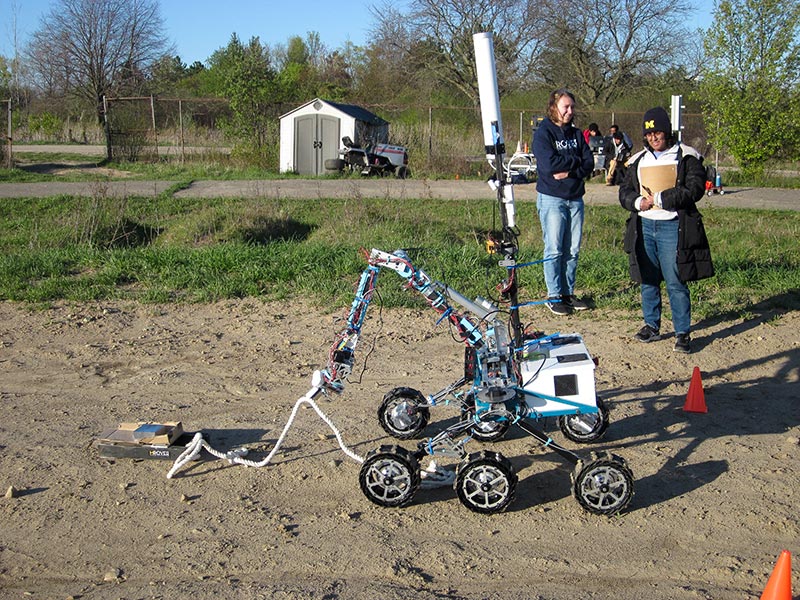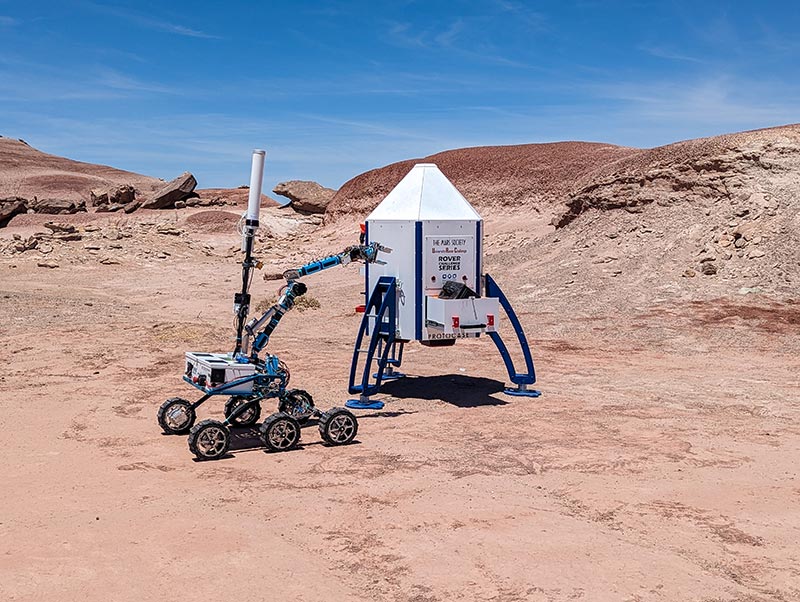
MRover Brings Home Top Ten Finish in International Competition
Students compete in the University Rover Challenge after devastating loss last summer

Students compete in the University Rover Challenge after devastating loss last summer
The University of Michigan Mars Rover Team (MRover) team took home a ninth place win at this year’s University Rover Challenge (URC) which took place over the weekend of May 29 at the Mars Desert Research Station (MDRS). The top ten finish was a cause for celebration for the team after a major setback last August, 2023, when the team lost all of their tools and equipment in a fire, forcing them to restart late into their design cycle.
The MRover student team, which works out of the Wilson Student Team Project Center, consists of over 120 students from the Michigan Aerospace Engineering Department and various other departments and majors throughout the University of Michigan community. Each year, the team travels to Hanksville, Utah to compete against teams from around the world at the URC. The competition was launched in 2006, challenging students to design and build a complete rover each school year and compete in realistic Mars missions. This year, MRover competed against 36 other teams in the finals, being one of only 11 teams from the United States.
Traditionally, the MRover team spends the summer designing a new rover for the upcoming school year, usually reiterating on existing hardware from previous years rovers. This year looked a little different, as the team spent the remainder of the summer purchasing new equipment and redesigning their rover from the ground up.
Throughout the fall semester, they pushed to complete their design and manufacture the chassis and the suspension. Even with the rushed timeline, the team returned from winter break with a rolling rover, having the chassis built, the suspension in place and the drive motors wired and integrated to control the rover’s drive system.
“It was a big challenge to overcome [the fire in August] but it gave the team the opportunity to just completely restart a lot of their design decisions, because we didn’t have any existing hardware to reiterate on. We had an empty space to just start from scratch,” explained MRover president Chloe Affaki.
Each year the team’s URC application is due the week of spring break, “The rover needs to be fully built and operational in all aspects, minus some minor tweaking that may be needed on certain components,” stated Affaki. For a spot in the finals, the team submits a video of their rover in action, competing against roughly 103 teams that apply.

After being accepted into the competition, the team focused on driver practice, final integration efforts, along with mock and practice missions. They emphasize having multiple configurations for their rover this year, featuring a science/mechanical configuration, an autonomous configuration with a camera and drive system, and an arm for pick-up and delivery tasks.
During the weekend of May 29, the team traveled to Utah with their fully redesigned rover. The weekend consisted of four total missions split across three days. On the first day, the team started with Equipment Servicing and Autonomy, typically performed back to back with just 10 minutes in between to switch configurations.
“A lot of our decisions when we are designing the rover are based on only having 10 minutes to take the arm off and get the rover ready to do the auton mission and pre-mission tasks,” the team stated. “When we were at the competition, the rover was performing extremely well!”
For the Equipment Servicing (ES) mission, the team set out to service a mock lander where the rover had to type on a keyboard, open doors, flip switches, etc. Here, the team did a full redesign on their arm, due to past years getting within a few points of the same score. Unfortunately, mid way through ES, the team broke part of their arm, causing them to end the mission early. “Despite that, we were still able to get every possible point we could have gotten up until then, so I am very happy with how the new redesigned arm performed and it goes to show that our redesign was definitely worth it,” Affaki commented.
Directly after this mission the team moved onto their Autonomy mission, where the rover drove autonomously to various checkpoints and was challenged to detect a water bottle and a mallet. The rover had to overcome multiple obstacle detection challenges and they successfully identified the mallet, though they were unable to identify the water bottle. “We still got one of the highest autonomy scores, which we usually tend to do since our software team is incredibly strong,” stated Affaki.
Day two was the team’s Science mission. The mission challenged the teams to core 10 centimeters into the ground, deeper than the current Mars rover goes, and collect soil samples. While they had difficulties with their rover’s torque transfer configuration and with analyzing the samples during this portion of the competition, the team was still able to earn one of the highest scores for the science mission.
On the final day of competition the team had their Delivery mission, where the rover was tasked to identify certain objects, pick them up, bring them to another location and drop them off. The team reported that they had issues with one of their wheels locking up during this phase of competition, and their arm had difficulty picking up the specified item required for the mission, however were still able to gather points. This final mission secured the team’s top ten finish while leaving them ready to get to work on the design of their next rover.
“We learned a lot about what we need to improve on for next year. Despite some of the challenges we faced and some of the failures we had in competition, we still performed really well and we are all very proud of how we did, especially considering our timelines were extremely tight this year and it was hard to get everything actually fully complete and working,” Affaki concluded.
The team’s adaptability throughout this past year’s setbacks showcased the perseverance and collaborative spirit within the University of Michigan. As they gear up for the coming school year and get ready for next year’s competition, they encourage students from around campus to join their community and collaborate on their new and improved rover as it begins to take shape.